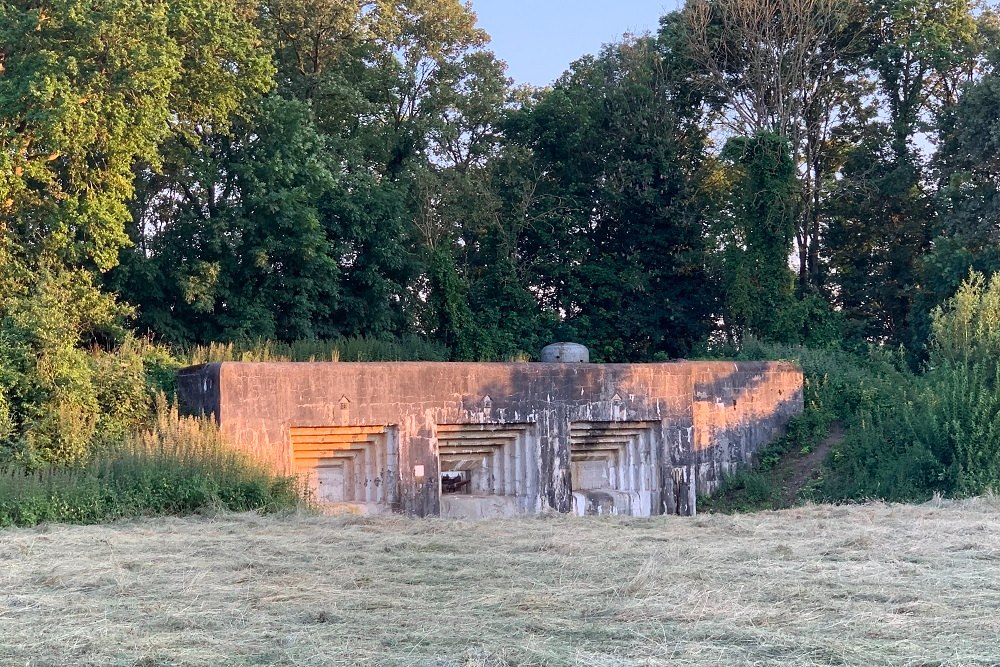Bunker Maastricht 2
This is the observation turret on artillery casemate Maastricht 2.
This bunker is located the west side of the fort and overlooks turret 120.
During the attack on the fort the Germans were anxious to eliminate the few observation points the fort had. It should be remembered that the gun bunkers themselves had no observation points of their own. They themselves could not look out except through the observation turrets on the various bunkers. These small turrets were equipped with a periscope that, even when the observation slots were closed from the inside, still allowed the fort to record its surroundings.
The turret on casemate Maastricht 2 was attacked on 10/11th May 1940. Witness the bullet impacts on the turret and the impact of the hollow charge (50 kg). This hollow charge was so powerful that it deformed the cavity in which the periscope was attached. Therefore, the periscope must have been put out of action immediately by this attack, which meant that casemate Maastricht 2 no longer had any observation possibilities. At this turret the effect of a hollow charge can be seen better than at turret 120. The impact of a hollow charge on steel was only 20 cm. However, the pressure wave from the blast broke off pieces of steel on the inside of the dome killing the two soldiers present, Private DAVID Albert and Brigadere MARCHOUL René.
Photo 4 shows the damage on the inside of the turret. The imprint of the hollow charge is clearly visible.
Also, they attacked cannon 3 (seen from the front, the most left cannon) with a hollow charge. At first they tried to place a hollow charge of 50 kg. But they could not get this one attached. The 12.5 kg hollow charge could be attached. The explosion slammed the cannon inside (photo 5), killing 2 soldiers, FERIRE Georges and PHILIPPE Paul, instantly, a third, VERBOIS Jean, died not much later. Because the cannon had slammed inward, the Germans were able to penetrate the casemate and opened fire on the remaining soldiers. They fled downstairs. The commander decided to abandon casemate Maastricht 2 and had the entrance doors to the casemate closed and guarded by 4 soldiers. They sat, as with casemate Maastricht 1, behind a pile of sandbags and a machine gun ready to further defend this access in case the doors were forced.
In this way, the German attackers tried to put every turret out of action, and the fort increasingly limited its observation capabilities. As indicated, the gun emplacements in the bunkers themselves, could not look outward. They depended on their observation posts. In retrospect, this turned out to be a flaw in the design.
After hef fort was captured, all the impacts caused by the hollow charges were filled with concrete. The reason for this was that the Germans did not want to reveal the effect of the hollow charges, which at that time was a secret weapon. The fort was used for propaganda purposes and various military dignitaries from friendly nations were shown around it. The unconquerable and strongest fortress in Europe, which Germany had forced to surrender in just 2 days.
The small holes on top of the dome were drillings by the Germans. They had taken samples after the battle to analyze the structure of the steel.
See also the damage done by a hollow charge of 50 kg on the cupola of bunker MN29 at Charneux ore bunker MN 18. At this turret, the damage has not been repaired and you can see very clearly what the concentrated explosion of nearly 3,000 degrees Celsius does to the turret of 36 cm thick steel. It burns completely through the steel and destroys everything on its way that it encounters. In the case of this cupola, the damage was not subsequently concealed with cement.
Do you have more information about this location? Inform us!
Source
- Text: Ed Lewandowski
- Photos: Ed Lewandowski
Nearby
Museum
- Fortress Eben-Emael - Eben-Emael (Bassenge)
- The Bridge of Vroenhoven - Vroenhoven (Riemst)
- Museum Maison du Souvenir - Hermalle-sous-Argenteau
Point of interest
- Position Anti-aircraft Section MiCA - Eben-Emael
- Temporary Cemetery Fallen Soldiers Fort Eben-Emael - Eben-Emael
- Fortress Eben-Emael - Administration building - Eben-Emael (Bassenge)
Monument
- Commemorative Plates Fort Eben-Emael - Eben-Emael (Bassenge)
- War Memorial Fort Eben-Emael - Eben-Emael (Bassenge)
- Memorial 20A Artillery Regiment Chasseurs Ardennais - Eben-Emael (Bassenge)
Cemetery
- Belgian War Graves Lanaye - Lanaye (Visé)
- Commonwealth War Grave Lanaye - Lanaye (Visé)
- Belgian wargraves Kanne - Kanne (Riemst)
Remembrance Stone
- Stumbling Stone Vroenhof 3 (now number 16) - Eijsden
- Stumbling Stones Diepstraat 55 - Eijsden (Margraten)
- Stumbling Stone Steegstraat - Eijsden
Fortification
- Fort Eben-Emael - Artillery Casemate Visé 2 - Eben-Emael (Bassenge)
- Turret Sud Bloc V Fort Eben-Emael - Eben-Emael
- Air Vent Fort Eben-Emael - Eben-Emael









